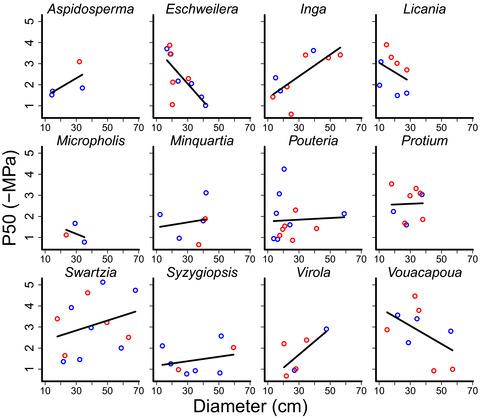当前位置:
X-MOL 学术
›
Glob. Change Biol.
›
论文详情
Our official English website, www.x-mol.net, welcomes your
feedback! (Note: you will need to create a separate account there.)
Amazonia trees have limited capacity to acclimate plant hydraulic properties in response to long-term drought.
Global Change Biology ( IF 10.8 ) Pub Date : 2020-03-30 , DOI: 10.1111/gcb.15040 Paulo R L Bittencourt 1, 2 , Rafael S Oliveira 2, 3 , Antonio C L da Costa 4 , Andre L Giles 2 , Ingrid Coughlin 5, 6 , Patricia B Costa 2, 3 , David C Bartholomew 1 , Leandro V Ferreira 7 , Steel S Vasconcelos 8 , Fernanda V Barros 1, 2 , Joao A S Junior 2 , Alex A R Oliveira 7 , Maurizio Mencuccini 9, 10 , Patrick Meir 6, 11 , Lucy Rowland 1
Global Change Biology ( IF 10.8 ) Pub Date : 2020-03-30 , DOI: 10.1111/gcb.15040 Paulo R L Bittencourt 1, 2 , Rafael S Oliveira 2, 3 , Antonio C L da Costa 4 , Andre L Giles 2 , Ingrid Coughlin 5, 6 , Patricia B Costa 2, 3 , David C Bartholomew 1 , Leandro V Ferreira 7 , Steel S Vasconcelos 8 , Fernanda V Barros 1, 2 , Joao A S Junior 2 , Alex A R Oliveira 7 , Maurizio Mencuccini 9, 10 , Patrick Meir 6, 11 , Lucy Rowland 1
Affiliation

|
The fate of tropical forests under future climate change is dependent on the capacity of their trees to adjust to drier conditions. The capacity of trees to withstand drought is likely to be determined by traits associated with their hydraulic systems. However, data on whether tropical trees can adjust hydraulic traits when experiencing drought remain rare. We measured plant hydraulic traits (e.g. hydraulic conductivity and embolism resistance) and plant hydraulic system status (e.g. leaf water potential, native embolism and safety margin) on >150 trees from 12 genera (36 species) and spanning a stem size range from 14 to 68 cm diameter at breast height at the world's only long-running tropical forest drought experiment. Hydraulic traits showed no adjustment following 15 years of experimentally imposed moisture deficit. This failure to adjust resulted in these drought-stressed trees experiencing significantly lower leaf water potentials, and higher, but variable, levels of native embolism in the branches. This result suggests that hydraulic damage caused by elevated levels of embolism is likely to be one of the key drivers of drought-induced mortality following long-term soil moisture deficit. We demonstrate that some hydraulic traits changed with tree size, however, the direction and magnitude of the change was controlled by taxonomic identity. Our results suggest that Amazonian trees, both small and large, have limited capacity to acclimate their hydraulic systems to future droughts, potentially making them more at risk of drought-induced mortality.
中文翻译:

亚马逊树响应长期干旱而适应植物水力特性的能力有限。
热带森林在未来气候变化下的命运取决于其树木适应干旱条件的能力。树木的抗旱能力很可能取决于其水力系统的性状。但是,关于热带树木在遭受干旱时是否可以调节水力性状的数据仍然很少。我们在12属(36种)的150棵树上测量了植物的水力性状(例如,水力传导率和抗栓塞性)和植物的水力系统状态(例如,叶水势,天然栓塞和安全裕度),茎的大小范围为14在世界上唯一的长期热带雨林干旱实验中,胸高直径为68厘米。经过15年的实验性水分亏缺后,水力性状没有显示出任何调节。这种调节的失败导致这些干旱胁迫的树木的叶水势显着降低,而树枝中的自然栓塞水平较高,但变化不定。该结果表明,栓塞水平升高造成的水力破坏很可能是长期土壤水分不足后干旱导致死亡率的关键驱动因素之一。我们证明了某些水力性状随树的大小而变化,但是,变化的方向和幅度受生物分类身份的控制。我们的结果表明,无论大小,亚马孙树木的水力系统适应未来干旱的能力都很有限,这可能使它们更容易遭受干旱导致的死亡风险。但分支机构中的本地栓塞程度各不相同。该结果表明,栓塞水平升高引起的水力破坏很可能是长期土壤水分不足后干旱导致死亡率的关键驱动因素之一。我们证明了某些水力性状随树的大小而变化,但是,变化的方向和幅度受生物分类身份的控制。我们的结果表明,无论大小,亚马孙树木的水力系统适应未来干旱的能力都很有限,这可能使它们更容易遭受干旱导致的死亡风险。但分支机构中的本地栓塞程度各不相同。该结果表明,栓塞水平升高造成的水力破坏很可能是长期土壤水分不足后干旱导致死亡率的关键驱动因素之一。我们证明了某些水力性状随树的大小而变化,但是,变化的方向和幅度受生物分类身份的控制。我们的结果表明,无论大小,亚马孙树木的水力系统适应未来干旱的能力都很有限,这可能使它们更容易遭受干旱导致的死亡风险。我们证明了某些水力性状随树的大小而变化,但是,变化的方向和幅度受生物分类身份的控制。我们的结果表明,无论大小,亚马孙树木的水力系统适应未来干旱的能力都很有限,这可能使它们更容易遭受干旱导致的死亡风险。我们证明了某些水力性状随树的大小而变化,但是,变化的方向和幅度受生物分类身份的控制。我们的结果表明,无论大小,亚马孙树木的水力系统适应未来干旱的能力都很有限,这可能使它们更容易遭受干旱导致的死亡风险。
更新日期:2020-02-14
中文翻译:

亚马逊树响应长期干旱而适应植物水力特性的能力有限。
热带森林在未来气候变化下的命运取决于其树木适应干旱条件的能力。树木的抗旱能力很可能取决于其水力系统的性状。但是,关于热带树木在遭受干旱时是否可以调节水力性状的数据仍然很少。我们在12属(36种)的150棵树上测量了植物的水力性状(例如,水力传导率和抗栓塞性)和植物的水力系统状态(例如,叶水势,天然栓塞和安全裕度),茎的大小范围为14在世界上唯一的长期热带雨林干旱实验中,胸高直径为68厘米。经过15年的实验性水分亏缺后,水力性状没有显示出任何调节。这种调节的失败导致这些干旱胁迫的树木的叶水势显着降低,而树枝中的自然栓塞水平较高,但变化不定。该结果表明,栓塞水平升高造成的水力破坏很可能是长期土壤水分不足后干旱导致死亡率的关键驱动因素之一。我们证明了某些水力性状随树的大小而变化,但是,变化的方向和幅度受生物分类身份的控制。我们的结果表明,无论大小,亚马孙树木的水力系统适应未来干旱的能力都很有限,这可能使它们更容易遭受干旱导致的死亡风险。但分支机构中的本地栓塞程度各不相同。该结果表明,栓塞水平升高引起的水力破坏很可能是长期土壤水分不足后干旱导致死亡率的关键驱动因素之一。我们证明了某些水力性状随树的大小而变化,但是,变化的方向和幅度受生物分类身份的控制。我们的结果表明,无论大小,亚马孙树木的水力系统适应未来干旱的能力都很有限,这可能使它们更容易遭受干旱导致的死亡风险。但分支机构中的本地栓塞程度各不相同。该结果表明,栓塞水平升高造成的水力破坏很可能是长期土壤水分不足后干旱导致死亡率的关键驱动因素之一。我们证明了某些水力性状随树的大小而变化,但是,变化的方向和幅度受生物分类身份的控制。我们的结果表明,无论大小,亚马孙树木的水力系统适应未来干旱的能力都很有限,这可能使它们更容易遭受干旱导致的死亡风险。我们证明了某些水力性状随树的大小而变化,但是,变化的方向和幅度受生物分类身份的控制。我们的结果表明,无论大小,亚马孙树木的水力系统适应未来干旱的能力都很有限,这可能使它们更容易遭受干旱导致的死亡风险。我们证明了某些水力性状随树的大小而变化,但是,变化的方向和幅度受生物分类身份的控制。我们的结果表明,无论大小,亚马孙树木的水力系统适应未来干旱的能力都很有限,这可能使它们更容易遭受干旱导致的死亡风险。











































 京公网安备 11010802027423号
京公网安备 11010802027423号